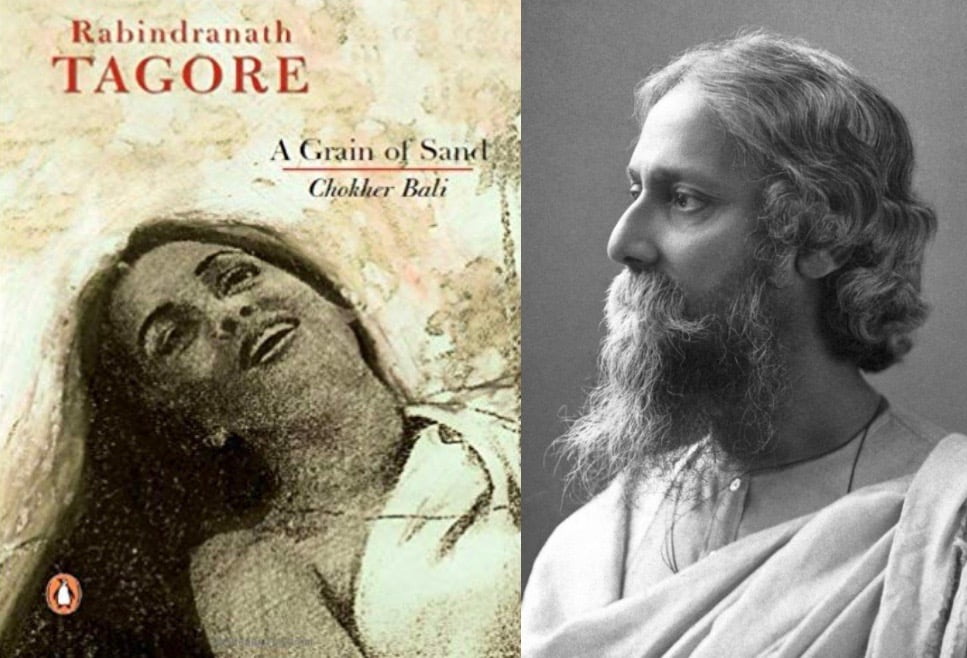Tagore’s writing reveals him to be an advocate for women’s education. His writings affirm the inhumanity of preventing women from accessing the same educational upbringing as men. Tagore’s sister Swarnakumari Devi was among the first Bengali women writers to gain prominence in India. Her education was also unconventional for the time as their father, Debendranth, put a halt on her mechanically taught education at school, and brought in a male teacher, Ajodhyanath Prakash, a male outside in the women’s quarters, thus defying strong cultural norms.
Book: Chokher Bali: A Grain of Sand
Author: Rabindranath Tagore (translated by Sreejata Guha)
Publisher: Penguin India, 2003
Genre: Fiction
Rabindranath Tagore’s 1903 Bengali novel Chokher Bali is often referred to as India’s first modern novel, where he highlighted the issues of women’s education, child marriage and the treatment of widows in 19th and 20th century Bengal. It was first serialised in the Bengali literary magazine, Bangadarshan first founded in 1872 by Bankim Chanra Chattopodhay and later resuscitated under the editorship of Tagore in 1901.
Chokher Bali traces the story of Binodini – a beautiful, convent educated widow who cannot easily endure society’s negligence. Binodini is rejected by Mahin, but he later marries the younger and uneducated Asha. Binodini becomes envious of Asha and Mahin’s marital bliss and uses Mahin’s mother Rajlaxshmi’s dislike of Asha to manipulate her way into their lives. Binodini’s increasing mental and sexual frustrations lead her on a path of revenge and manipulation. The novel explores the extramarital affair between Binodini and Mahendra, her friendship with Asha, and her real feelings for Bihari, Mahindra’s friend. Tagore presents the complexity and fragility of human relationships through psychological

The term ‘Chokher Bali’ literally means an irritation in the eye or an eyesore, which is what Asha and Binodini become for each other. Binodini is presented in many avatars a hopeless widow, a friend, a temptress, and a remorseful woman. Tagore gives readers an insight into her desires and longings, the feeling that many widows at the time had silently undergone. On the other hand, Asha is presented as naive and innocent, which combined with her illiteracy initially results in her subjugation. The narrative almost becomes an implicit debate on love and morality, urging readers to understand Asha and Binodini outside of the social norms of Bengali society.
“If education is a tool for human development and if education is the birth-right of a human being, I do not understand how we can deprive the women from education.”
Rabindranath Tagore’s European Diary. 1881
The central character Binodini is not an idealised Indian woman but a woman with shades of grey and very human flaws. Binodini cannot come to terms with her life as a widow, as she is still young and has wants and desires. She feels wronged as she believes she is superior to Asha in all respect and deserves the life she is living. Tagore’s depiction of Binodini is impressive as she subverts the expectation of society for widows to forgo all worldly desires.
In Chokher Bali, Tagore draws parallels between the educated and the uneducated through Asha and Binodini. According to Mary Wollstonecraft “girls that have been… weakly educated are often left by their parents without any provisions”. Binodini is likewise left without any financial provision, but is left with education which allows her the liberty of free thinking. Binodini represents a new female subjectivity whom western education transforms into a woman with her own heart and mind, and is not tied to traditional customs.

Asha is a poor orphaned girl, which
Binodini’s education is what helps her survive in a world where
Also read: Kadambari Devi: Rabindranath Tagore’s Literary Companion | #IndianWomeninHistory
Tagore does not put Binodini on a pedestal and exempt her of any fault, but instead humanises her and shows readers the complexity of human nature which can cause the most rational beings to act irrationally. Through, Binodini and Asha, Tagore shows the importance of education. There is an imbalance in power due to an imbalance in education between the educated and uneducated characters. Both Binodini and Mahin hold a certain kind of dominance and power over Asha as they are both educated and able to use literature and poetic language in their interactions, be it covertly or overtly, and Asha is unable to understand.

The novel is full of
D
espite his progressive portrayal of Binodini and Bihar, he does not allow them to marry at the end.
Tagore shows the intellectual interchange between the characters, possible due to education and the interception of letters. The innocent and illiterate child bride Asha fails to understand the exploitation she faces at the hands of her husband and dear Bali (Binodini) whom she trusted blindly. Tagore does not justify Binodini’s actions and actually is sympathetic to Asha, perhaps stressing that Asha would have been able to avoid Binodini’s interference in her marital life, if she were educated enough to understand the intentions behind her friendly nature.
However, one of Tagore’s greatest regrets in the novel is the ending. Despite his progressive portrayal of Binodini and Bihar, he does not allow them to marry at the end. Although, today we may see the girl marrying the guy as regressive today in Tagore’s time a widowed woman was not permitted to re-marry. Thus, ending the novel with Binodini and Bihari marrying would have been the most revolutionary.
Also read: Finding Feminism In Rabindranath Tagore’s Streer Patra
A century after Chokher Bali, education is still a struggle for many women to access easily globally. Tagore’s novel is radical and unconventional presenting a viewpoint that is ahead of the conservative times of 19th and 20th century India. Through the story of Binodini, Tagore questions the societal norms. He condemns all kinds of taboos and unjust customs which deprive women and especially widows of their rightful freedom and autonomy; confined to live a mournful colourless life. As a man from a privileged background, his understanding of the emotions of Indian women and his empathetic attitude towards them is remarkable.
Note: This piece has been adapted from a section of my BA dissertation ‘Rabindranath Tagore and Women’s Emancipation in A Grain of Sand: Chokher Bali’
About the author(s)
Nikhat is a Civil Servant and Communications Manager for BBPC Poetry Collective. Her academic research interests include wartime gender-based violence and intersectional feminist historiography.





